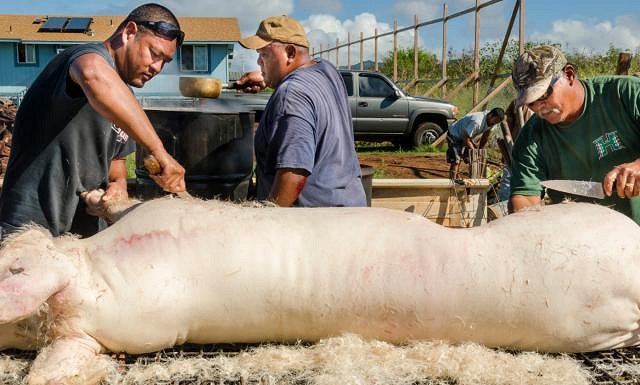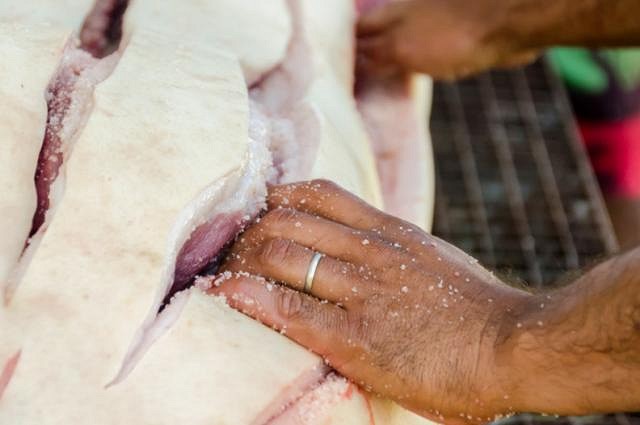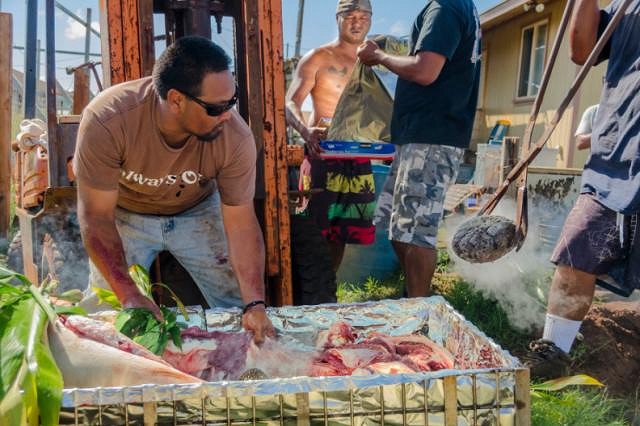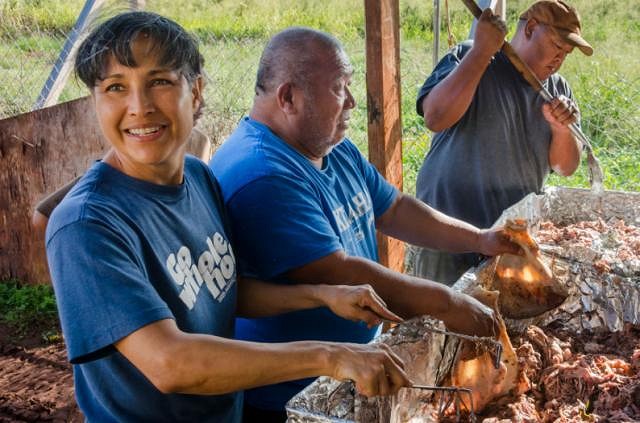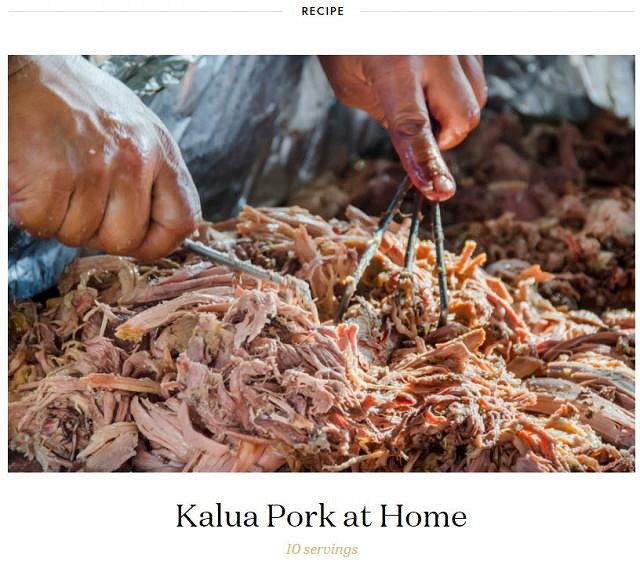Tiki Central / Tiki Drinks and Food
Kalua Pork
Pages: 1 25 replies
|
V
VampiressRN
Posted
posted
on
Sat, Feb 3, 2007 5:56 PM
I just got a nice little book today "Hawaii's Best Tropical Food & Drinks" and it has what looks like a very easy recipe for Kalua Pork. Take a peek at it and let me know if any of you chefs out there have additional tips. (I am cooking challenged.....but willing to try!!!) Boneless Pork Raost Preheat oven to 500 degrees. Brush roast with liquid smoke and garlic; sear in oven for 10 minutes. Reduce heat to 275 degrees. Combine soy sauce and chili powder. Brush on roast, insert meat thermometer and roast until medium well. Combine butter, rum, brown sugar and peaches in a small saucepan and stir constantly until melted. Brush over roast and sprinkle with nuts. Continue cooking 10 to 15 minutes. Slice and serve. SOUNDS YUMMY!!! |
|
T
thistle
Posted
posted
on
Sat, Feb 3, 2007 6:13 PM
I've never tasted authentic kalua pork,but it sounds a little sweet to me. Good pork, well-roasted, has a sweetness of its own, that lends itself to all sorts of accompniments. I like to smoke a Boston butt or picnic ham in my electric smoker, for several hours, & usually just s&p them-then I shred it, top some w/ a carolina bbq sauce (lots of vinegar), my kids like it plain. It's good on biscuits, w/ sides of greens & cornbread, topping a salad, tossed w mac n' cheese. I think your pork recipe would be better if you simplified the pork, then did fruit & nuts on the side, as a chutney or topping,-I love soy & garlic, though...! |
|
K
Koolau
Posted
posted
on
Sun, Feb 4, 2007 6:01 AM
That sounds delicious, but it's not kalua pig as I know it. Kalua pig is a smokey pulled pork, often mixed with cabbage, and served with rice - that's the normal plate lunch type presentation. It's not sweetened, fancy, or sprinkled with mac nuts. |
|
C
Cammo
Posted
posted
on
Sun, Feb 4, 2007 6:37 AM
It's usually spelled 'Kahlua Pork" to help with how you pronounce it; the real recipe, very easy to make in a cooking bag - Kahlua Pork Large Pork Shoulder Trim the fat from the pork. Place it, the chicken broth, salt and the liquid smoke in the cooking bag, (buy it in the Saran Wrap section of your grocery) pierce the top of the bag with a few tiny holes, and bake in a cooking pan for 3 1/2 hours at 325°. (Turn over at 1 1/2 hours, to moisten it, then rotate again at 3 hours) At 3 1/2 hours, turn the oven to its lowest setting, 125° and let the pork sit for another 2 hours. Then turn the oven off, but don’t open the door, and let it sit for another 2 hours in the juices. The pork should fall apart easily at the end; just flake with a fork. Slice the cabbage thinly and mix with the Aloha Shoyu into the pork with chunks of pineapple for decoration. Yup, it's 7 1/2 to 8 hours cooking time, but that's the point. It mimics true pit-roasted pork that slowly cooks for 24 hours sometimes. The whole thing should be soft, juicy, and just fall apart in your mouth at the end. Serve with rice. You can serve a large party with this stuff. |
|
V
VampiressRN
Posted
posted
on
Sun, Feb 4, 2007 10:53 AM
That cooking bag sounds like the ticket. I wonder if the recipe I posted was spelled that way because it is not the traditional Kahlua pork....interesting....but all of this is making me hungry. What is Hawaiian salt? I have Sea Salt, but it is from the Mediterranean. |
|
C
Cammo
Posted
posted
on
Sun, Feb 4, 2007 2:10 PM
Salt is salt. Don't sweat the details, V. |
|
K
Koolau
Posted
posted
on
Mon, Feb 5, 2007 1:05 AM
Cammo, Cammo - Kahlua is a Mexican coffee liqueur - kalua is the pig from the imu. Your recipe sounds great, and that long cooking time makes sense. But to be more authentical, use regular green head cabbage. |
|
V
VampiressRN
Posted
posted
on
Mon, Feb 5, 2007 6:29 AM
What is pig from the imu? Sorry for the dumb question. :( |
|
C
Cammo
Posted
posted
on
Mon, Feb 5, 2007 7:10 AM
I've found it spelled both ways, and always go for the more phonetic spelling (why isn't 'phonetic' spelled the way it sounds?!) - and yes you usually use green cabbage, but "Ono's", a local restaurant here uses red. They slice it paper thin, and actually quickly stir-fry it with a touch of brown sugar and soy sauce before adding it to the pork. It's freakin' yummy, and looks brighter. It's a matter of taste. Hey, if you have sea salt or pink Hawaiian salt, sprinkle a bit on top at the end for taste and decor. Dig in. |
|
M
mieko
Posted
posted
on
Mon, Feb 5, 2007 4:34 PM
My cousin-in-law (is that right?) is from hawaii and made some for us recently. His recipe was basically the same as this: After cooking, you can add more salt to taste if needed. |
|
K
Koolau
Posted
posted
on
Mon, Feb 5, 2007 10:16 PM
VampiressRN - the "imu" is the underground oven into which the pig is placed along with taro root, sweet potatoes, etc., and baked with heated rocks. The whole thing is covered with banana leaves to seal in the heat and moisture, and the food slow cooks for many hours. You've seen photos, I'm sure. Nowadays, the imu usually consists of a roasting bag and some liquid smoke, but oh well, modern convenience. |
|
F
frostiki
Posted
posted
on
Thu, Feb 8, 2007 7:56 AM
While I normally applaud authenticity, I like the modern convenience of not having to cook a whole pig, and destroy my backyard to cook it. I like the "imu" I have it's made by Frigidaire, and self cleaning. |
|
V
VampiressRN
Posted
posted
on
Fri, Feb 9, 2007 5:55 AM
Thanks Koolau....I found this artical based on your information. imu |
|
T
tikiwinebear
Posted
posted
on
Fri, Feb 9, 2007 8:10 AM
For those of us who are a bit more "time challenged" I might suggest the Carnitas from Costco. After a couple of tiki parties / luaus where we made our pork with similar recipes as posted, we needed to cut down preparation time so we could supply our guests with a nice variety of luau foods. Locating pre-packaged Carnitas (roasted pork) at our local Costco, we simply followed the directions on the package (microwave 4 minutes, poke holes in wrapping, and microwave another 4 minutes), shredded the pork pieces using forks, added a little Hawaiian salt and liquid smoke to the finished pork, and microwaved for a couple minutes more. We had some fantastic tasting kalua pork with less time and effort. And don't forget the POI!!
|
|
V
VampiressRN
Posted
posted
on
Sun, Feb 11, 2007 8:39 PM
That is good to know. I am all for reducint prep time and am good with a microwave. :) |
|
B
Blowfish
Posted
posted
on
Mon, Feb 12, 2007 8:43 AM
...I'll add that I tend to add more liquid smoke, fresh ginger and even a small amount of honey to the more original recipe... then wrap it in banana leaves I get from the Asian market near where I live, slow cook it in the oven... yum! [ Edited by: Blowfish 2007-02-12 08:43 ] |
|
P
procinema29
Posted
posted
on
Tue, Feb 13, 2007 2:53 PM
All these recipes and variations sound really yummy, you know! I just wanted to say. Also, I know that definitions of these terms and recipe names vary greatly from region to region and even household to household. Growing up with a lot of Hawaiians in the family, I had the general understanding that "kalua pig" referred to when the whole animal was cooked, traditionally in the imu, and "kalua pork" referred to a smaller version of the recipe with only a section or two, and generally cooked in your kitchen oven. When I was a kid I was told this was a very high-end dish, "fit for royalty," and a person must be living the good life if they're eating it. |
|
K
Krakatowa
Posted
posted
on
Wed, Jul 11, 2007 9:17 AM
I whole heartily disagree with this statement. There are considerable differences in salt flavors, textures, and the various layers they can add to a dish. When I make Pua 'a Kalua, or any other dish for that matter, I take the salt into consideration. I have found that sea salt is perhaps the best choice. Avoid Kosher salt (Yellow of Prussiate is often added) and never use table salt! If you really want to up the ante, you can use Fleur de Sel from France... the best salt in the world as far as taste and mouth feel. There are some Hawaiian salts out there, various hues and textures, but for my money... I just use Trader Joe's Sea Salt. Good, clean, nice texture, and cheap. I'll see if I can dig up my recipe for Pua 'a Kalua, I'm still unpacking from the move (almost a year now). |
|
TK
Tiki Kaimuki
Posted
posted
on
Wed, Jul 11, 2007 2:59 PM
Okay, I don't know what all that sweet stuff was from the first recipe, but forget it! First thing you need is a nice pork butt-fattier than the shoulder, but a fatty shoulder could do. The fat is important as it bastes the meat and provides juice to let the shredded kalua(the only spelling if you're talking Hawaiian pork)swim in. |
|
D
disneydan
Posted
posted
on
Fri, Jul 13, 2007 9:39 PM
I found a great recipe that I have used twice, and got great results both times. You can find it at http://www.melindalee.com go to recipe archives and search for Hawaiian Kalua Pig in the oven. It is a very simple recipe that basically calls for the pork, Hawaiian salt and liquid smoke. The secret it that the pork roast is wrapped in banana or ti leaves (just like at a Luau) it imparts the flavor that most recipes miss. I live in so cal, so banana leaves are very easy to find at Mexican markets - you might also find them at Asian markets or have your florist get you Ti leaves (no pesticides!) The recipes that call for all that sweet stuff are probably yummy, but they are not traditional Kalua pork. Have fun!! |
|
C
Capt_Biggins
Posted
posted
on
Thu, Jul 19, 2007 1:33 PM
with the recipe you mention- what is that total for a large party 20-25?? [ Edited by: Capt_Biggins 2007-07-19 13:34 ] |
|
S
Swanky
Posted
posted
on
Thu, Aug 16, 2007 1:25 PM
I just came across this nice step by step methoc for cooking kalua pig. If you have a banana tree you can cut down, it'll make it all a lot easier. Makes me tempted to try. [ Edited by: swanky 2007-08-17 05:48 ] |
|
JD

Johnny Dollar
Posted
posted
on
Thu, Aug 16, 2007 1:31 PM
linky no worky |
|
S
Swanky
Posted
posted
on
Fri, Aug 17, 2007 5:49 AM
Linky fixey |
|
JD

Johnny Dollar
Posted
posted
on
Fri, Aug 17, 2007 6:24 AM
thanky swanky |
|
A

AceExplorer
Posted
posted
on
Thu, May 31, 2018 12:40 PM
I spotted another crock pot Kalua Pork recipe posted on Taste.com 10 days ago with some nice photos. I pasted it here with photos. This might not be as good as the previous recipe posted here (no banana leaves, etc.) but for those who might be in the middle of winter and can't get those items, this may work fine in the interim. I'm going to try this at some point soon and will post comments here. =============================
On the Hawaiian island of Kauai, cooking a 300-pound sow involves forklifts, lava stones, and a lot of patience. Smoke billows from a large dirt patch in Kimo’s backyard, loading the air with a woodsy scent. No fence or trees shelter his plot. This is the hot, dry side of Kauai—near the city of Eleele—and the midday sun blasts the ground. A mound of dirt shelters a pit, its interior stuffed with steaming lava stones that hiss and mesquite logs (kiawe) that sputter. This underground oven is called an imu, and food that’s cooked in one is called kalua. About 1,500 years ago, Hawaiians used an imu to cook suckling pigs, chickens, breadfruit, sweet potatoes, and taro. Today, mature hogs are typically cooked in an imu for nightly luaus at the few resorts that dot the island. And even though most Hawaiian residents don’t have an imu pit in their backyard, kalua pig is as natural to Hawaii as rainbows and waterfalls. It’s listed on many restaurant menus and stocked in the grocery store’s frozen section.
Kimo’s catering business is old-school and informal. He doesn’t advertise, and there’s no website or social media. Locals either know him or use the “coconut wireless” to find him (Hawaii’s favorite word-of-mouth method of communication). For nearly 20 years, he’s cooked kalua pig for celebrations such as graduations, weddings, and anniversaries. On this sunny afternoon, he will kalua two 300-pound sows from a local named Val. Her family runs a pig farm on the south shore, and she’s gifting her clients with gallon-size bags of kalua pig. Kimo’s imu is about 12 feet in diameter, four feet deep, and lined with puka rocks the size of basketballs. “Puka” means hole, and the lava rocks Kimo has collected are naturally full of them, which prevents trapped steam from building pressure and exploding. A fire was built on top of them eight hours earlier, with smaller rocks stacked between the wood. Whack! A guy splits banana tree trunks with an ax. They’ll be added to the fire for moisture and flavor. Eight men cluster around two metal tables. The freshly slaughtered sows stretch between them. Two men singe hair along the pigs’ bodies, filling the air with a bitter smell. Afterward, they use a sharp chef’s knife to shave the burnt hair from the skin until it’s as bald as a baby’s head. Kimo slices the bellies open, reaches inside and scoops out the guts, then gives the carcasses a thorough rinse.
On a January evening in 1778, Captain James Cook docked along the Waimea River on Kauai. He and his crew were the first Europeans to meet a thriving community of native Hawaiians. The island was divided into six neighborhoods, called moku, and each moku contained subdivisions called ahupua’a (pronounced ah-hoo-poo-ah-AH). Each ahupua’a, 67 in all, began as a point at the top of a mountain, then fanned into a base along the shore. Altars (ahu) made with the head of a pig (pua’a) marked boundaries. At Kimo’s, the pigs’ heads are not used to divide property lines, but reserved for soup. Legs, sides, and shoulders are scored deep, and joints are cut so they’ll lay flat in huge metal baskets. A thick layer of sea salt, from the town of Hanapepe, just seven miles up the highway, is spread across the ribs and pushed into gashes. The pigs are moved to the shade, where a young woman stands over them, fanning flies with a single ti leaf. Men line the baskets with tinfoil and banana leaves and put pig parts inside. With large metal tongs, Kimo pulls small, steaming rocks from the pit and puts them into each seasoned body cavity. Guys drape banana leaves across, then tuck the pigs in with a final layer of tinfoil. Someone tosses two-foot lengths of banana-tree trunks into the pit, which land with a thud and a sizzle.
Kimo climbs into a forklift—before forklifts, an imu was generally reserved for cooking smaller food items, like breadfruit, sweet potatoes, and chicken—and lowers the baskets onto the coals, rocks and steaming banana trunks. Men surround the pit and cover the baskets with a wet canvas tarp, then top that with a thick plastic tarp. Dirt is shoveled around the edges and the plastic tarp inflates with hot air until it resembles a clear dome. The pigs are left like this to cook overnight. As Kimo and his men unearth the baskets, morning sun crests the Pacific Ocean. Women circle two plastic tables, peeling tinfoil and banana leaves from limp carcasses. Steam carries the scent of roasted meat into the air. The flesh wiggles and jiggles as long strands of ropy meat are separated from fat, bones, and skin. The essence of banana mingles with salt, rendered pork fat, and smoky meat—the signature flavors of kalua pig.
INGREDIENTS Since most Hawaiians don’t have an imu in their backyard, they make kalua pig in a crockpot. To offset the pork’s salty, rich and smoky flavors, locals typically serve it with steamed white rice, boiled green cabbage and poi. Cover a crockpot insert with a thin layer of cooking spray. Combine the water and liquid smoke and pour into the crockpot. Rinse the pork and place it inside. Rub salt all over. Secure lid and cook on low for 7 hours. Turn the crockpot off and let the pork rest for 1 hour. |
Pages: 1 25 replies



